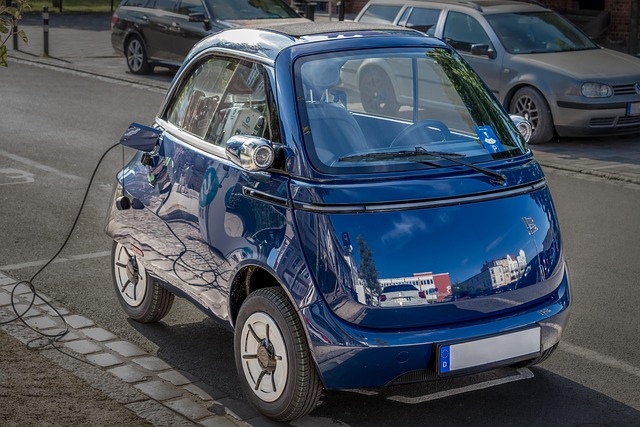Businesses embracing sustainable fleet management reduce their carbon footprint and gain economic advantages by adopting Select Electric Vehicles (EVs). These zero-emission vehicles, including affordable electric SUVs and advanced bus technology, offer lower maintenance costs. A strategic transition involves assessing current fleets, setting goals, and implementing charging infrastructure. Recent advancements in charging technology and the success of many organizations prove the benefits of EVs. Governments incentivize Select Electric Vehicles with tax breaks and subsidies to support the shift towards cleaner transportation.
In today’s eco-conscious world, sustainable fleet management is no longer an option but a necessity. This comprehensive guide explores the multifaceted approach to transforming traditional fleets into environmentally friendly operations. We delve into the pressing need for change, highlighting the benefits of adopting electric vehicles (EVs) and providing a step-by-step transition strategy. From cutting-edge charging infrastructure to real-world case studies, this article equips businesses with insights to make informed decisions when selecting electric vehicles for their fleets.
- Understanding Sustainable Fleet Management: The Need for Change
- Benefits of Adopting Electric Vehicles for Your Fleet
- Strategies to Transition Your Fleet: A Step-by-Step Guide
- Technology and Innovations in EV Charging Infrastructure
- Case Studies: Successful Implementation of Sustainable Fleet Practices
- Policies and Incentives Supporting the Shift to Electric Fleets
Understanding Sustainable Fleet Management: The Need for Change

In today’s world, where environmental consciousness is on the rise, sustainable fleet management has become a pivotal strategy for businesses aiming to reduce their carbon footprint. Traditional gasoline-powered vehicles contribute significantly to pollution and greenhouse gas emissions, making it imperative to embrace greener alternatives. The transportation sector, with its vast fleet of vehicles, holds a crucial role in this transition. By adopting sustainable practices, companies can not only minimize their environmental impact but also reap economic benefits.
One of the key aspects of this shift is the strategic decision to Select Electric Vehicles (EVs). Electric cars and SUVs offer a viable solution by providing zero-emission transportation options, especially for urban areas. The market now boasts an array of affordable electric SUVs for families, catering to diverse needs while promoting eco-friendly mobility. Moreover, low maintenance electric cars reduce operational costs compared to their internal combustion engine counterparts, making them an attractive choice for businesses seeking long-term savings and environmental sustainability. Green fleet management software solutions further streamline this process, enabling efficient tracking, scheduling, and monitoring of EV fleets.
Benefits of Adopting Electric Vehicles for Your Fleet

Adopting electric vehicles (EVs) for your fleet offers a multitude of benefits, both environmentally and financially. By selecting electric vehicles, businesses can significantly reduce their carbon footprint, contributing to cleaner air and mitigating climate change impacts. EVs produce zero tailpipe emissions, making them a key component in the transition towards sustainable transportation for long trips and public transport networks.
Moreover, electrifying your fleet can lead to substantial cost savings over time. Although initial investment costs may be higher than traditional vehicles, lower operational expenses associated with EVs include reduced fuel and maintenance costs. Long range electric buses for public transport are becoming increasingly efficient, ensuring reliable and environmentally friendly transportation options without compromising on distance or speed.
Strategies to Transition Your Fleet: A Step-by-Step Guide

Transitioning your fleet to sustainable practices is a significant step towards a greener future. Here’s a simplified guide to help you navigate this change:
1. Assess Your Current Fleet: Start by evaluating your existing vehicles and their utilization patterns. Identify areas where green energy vehicle options can be introduced, such as replacing older diesel models with electric cars known for their excellent range and performance. This step is crucial in understanding the scope of your transition.
2. Set Clear Goals: Define specific sustainable goals aligned with your business objectives. Consider the environmental impact and cost savings potential of this shift. You might aim to reduce carbon emissions by adopting electric vehicles (EVs) or explore green energy logistics and shipping options for a comprehensive approach.
3. Select Electric Vehicles: Research and choose EV models suitable for your fleet’s needs. Look beyond range anxiety and consider the technological advancements in battery technology that offer longer journeys between charges. Ensure the selected EVs align with your operational requirements, including cargo capacity and vehicle types.
4. Implement a Charging Infrastructure: Plan and install charging stations at strategic locations to support your new EV fleet. This step is vital for ensuring efficient operations and addressing any range-related concerns among drivers.
5. Train and Educate Staff: Prepare your team for the transition by providing training on sustainable practices, EV technology, and safety protocols. Empower them to adopt these changes confidently, fostering a culture of environmental responsibility within your organization.
Technology and Innovations in EV Charging Infrastructure

The rapid growth of electric vehicle (EV) adoption has spurred significant advancements in charging infrastructure technology. Innovations such as fast-charging networks and wireless charging stations are transforming how we power our vehicles, addressing range anxiety and making EV ownership more convenient. These developments are particularly crucial for fleets, which often face demanding schedules and require efficient recharging solutions. For instance, top-rated electric trucks for work are now equipped with advanced battery management systems that allow for rapid refueling, mirroring the efficiency of traditional fuel stops.
Moreover, charging infrastructure is evolving to support a wider range of EV types, including electric cars with advanced driver assistance systems (ADAS). Smart charging stations can now communicate with vehicles, optimizing charge times and managing energy demand during peak hours. This integration ensures that urban commuting with electric vehicles becomes smoother and more sustainable, contributing to reduced emissions and improved air quality in densely populated areas.
Case Studies: Successful Implementation of Sustainable Fleet Practices

In recent years, numerous organizations have successfully adopted sustainable fleet management practices, demonstrating that environmental responsibility and operational efficiency can go hand in hand. One notable trend is the widespread adoption of electric vehicles (EVs). Companies like Tesla, with its top-rated electric cars under $30,000, have made affordable, eco-friendly transportation options more accessible. This shift has been particularly evident in urban areas, where businesses are embracing green energy logistics and shipping options to reduce their carbon footprint. For instance, delivery services are transitioning to best long range electric cars, enabling them to cover more ground without emitting harmful pollutants.
These case studies offer valuable insights into the practical implementation of sustainable fleet management. By selecting electric vehicles and integrating green energy logistics, companies can significantly cut down on operational costs and environmental impact. Such initiatives not only contribute to a greener future but also enhance corporate image and attract environmentally conscious customers and employees.
Policies and Incentives Supporting the Shift to Electric Fleets

Many countries are promoting a shift towards sustainable fleet management by encouraging businesses to adopt electric vehicles (EVs). Governments and organizations are implementing policies that support this transition, recognizing the environmental benefits of reducing carbon emissions from transportation. One significant strategy is offering incentives for companies to purchase and operate electric fleets. These incentives can include tax breaks, grants, and subsidies, making EV adoption more financially attractive.
The rise in popularity of electric vehicles is also driven by advancements in charging infrastructure. Rapid charging stations are becoming increasingly accessible, addressing a common concern for businesses—the fear of range anxiety. This technology allows for quicker battery recharging, making it convenient for fleet managers to keep their vehicles on the road for extended periods without significant downtime. With the availability of best electric vehicles for winter driving and efficient rapid charging cars, green energy vehicle options are becoming a realistic choice for many companies aiming to reduce their environmental footprint.
Sustainable fleet management is not just a trend but an urgent necessity, as evidenced by the growing need for eco-friendly transportation solutions. By adopting electric vehicles (EVs) and implementing strategic transitions, businesses can significantly reduce their carbon footprint. The article has explored various aspects of this shift, from understanding the importance to exploring innovative technologies and successful case studies. In light of these insights, it’s clear that selecting electric vehicles is a pivotal step towards a greener future. Governments and industries must collaborate to enhance EV charging infrastructure and provide incentives, ensuring a seamless transition. This comprehensive approach will not only benefit the environment but also drive economic growth in the burgeoning sustainable transportation sector.
